What is the infrared heating of a private house
The geographical location of our country implies the unconditional use of various heating systems for apartments and private houses. If in the first case there is practically no alternative to central heating, then in the second, the owners have a choice. One of these options is infrared heating, which can evenly heat the room, while saving energy.
Today we will not deal with other ways of feeding these systems, but focus on their features.
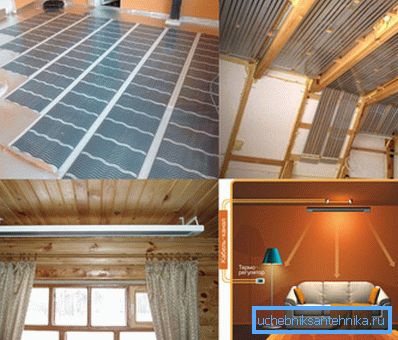
General information about IR heating
Below are the highlights of this heating system:
- Unlike water or steam heating, the principle of infrared heating is somewhat different - it does not warm the air in the room, and all the energy is spent on heating objects and surfaces.
- At the second stage, they transfer the accumulated heat to the atmosphere of the room, creating a comfortable temperature balance.
- In this case, the convection movement is not formed, when the cold air masses displace the warm ones, as a result of which they accumulate under the ceiling.
- The room is heated evenly throughout its space and the air temperature at any point in the room is the same.
- An important point is the energy-saving ability of infrared heating, which makes it possible to save about half of the electricity when compared with conventional electric heating of housing.
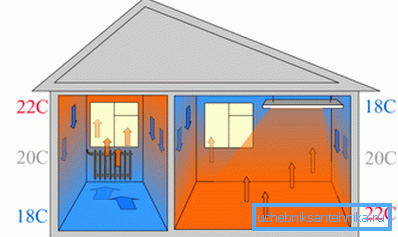
Ceiling infrared heating system
In this case, the heaters are hung from the ceiling, directing the heat flow down and slightly to the sides. Thus, the main surface that will be heated by infrared rays is the floor covering.
At the level of the legs in this case, the temperature will be about two degrees higher than near the head. If to compare with the convection method, this surface is always the coldest, while under the ceiling of warm air with excess.
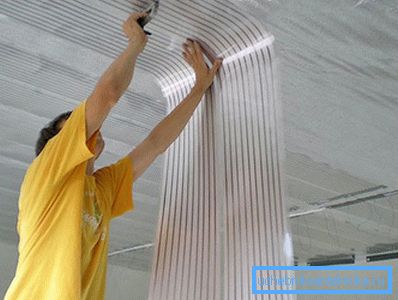
The design of the ceiling infrared heater:
- heating element, which can be made of ceramic, tungsten or quartz. The efficiency and power of the equipment depends on the material;
- reflective aluminum plate capable of emitting electromagnetic waves of a given length.
Often, ceiling heaters are used as an auxiliary heat source for a private house. At the same time, the useful area of the room will not be taken, which is very important.
Tip: if used to maintain the background temperature in a room using a different type of heating, ceiling infrared heaters can create “islands” of heat in the work area or in recreational areas.
The temperature sensor installed in the equipment will turn it off when the selected temperature is reached and turn it on again when the air in the room becomes cool. Due to this, it is possible to save a considerable amount of electric energy.
Another important plus devices - mobility. You can quickly dismantle IR heaters from the ceiling and transport them to another place.
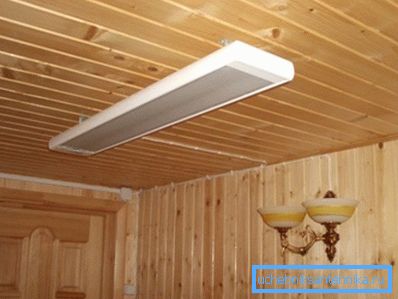
It is possible to install infrared film heating in the ceiling space of the house, which allows you to maintain the height of the room and the area of the living space. This aspect is especially important on the attic floors, where the ceiling is of a sloping type, and the walls are small in size.
Recently, a new type of ceiling IR panels has been added to the market of finishing materials, which can be installed in an Armstrong-type profile - an economical and simple solution for heating common areas in a house.
Tip: do not direct the heating flow to the area of the human head. Also, do not mount the equipment on a stretch ceiling made of plastic lining or PVC film. Do not place IR heaters below 1.5 m from the floor.

Wall-mounted infrared heating system
Infrared panels mounted on the wall can be a good alternative to conventional heating with radiators. They have a small thickness and a large variety of sizes, installation is not particularly difficult, so it is often carried out with their own hands.
IR panel heaters are produced in the form:
- wall-mounted, which are installed instead of the usual radiator in the window sill;
- designer wall sizes and in a wide range of colors;
- slats warm skirting, installed around the perimeter of the room instead of the traditional plinth.
A universal option for wall heating is considered a film heating system, which is installed in the thickness of the wall. It is advisable to install such a heat source indoors, in which one or several external walls. In this case, sufficient heating of the planes is ensured, protecting them from freezing and the formation of mold.
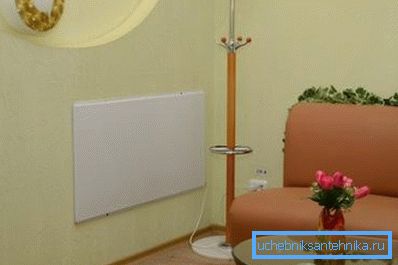
Tip: when installing an infrared film system, you must use a shielding film that prevents heat loss.
Floor heating system
In this case, film mats with flat heating elements connected in series are used. Due to the minimum thickness of this heating system, it is possible to mount a warm floor under almost any finishing coating - tile, laminate, linoleum or carpet. In this case, the height of the room will not change.
The best heat dissipation in combination with ceramic tiles, slightly worse - with laminate. The largest shielding of IR radiation will be with carpet and linoleum.

The installation of the infrared film is done in a short time; no dirty work is required, as, for example, when installing a water heated floor. Decorative flooring can be installed immediately, which in the above case can not be done.
Tip: the instruction does not recommend placing the IR film under the furniture, firstly, it will reduce its heat transfer, and secondly, it can provoke the drying out of structures made of chipboard and wood.
Advantages and disadvantages
You can not ignore the pros and cons of the system:
| Positive traits |
|
| Negative qualities | The applied principle of electromagnetic radiation has not yet been fully followed, and one cannot say for sure how it affects our body. Also on the heating surfaces static electricity gradually accumulates, which is able to attract dust. The equipment price is high, its payback will be several years. Zone heating with infrared radiation costs relatively little money, but using it as the main source of heat sometimes results in a large amount. It is believed that the excessive heating of surfaces in this way in the room adversely affects the work of household electrical appliances. |
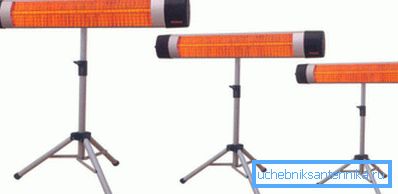
Conclusion
The use of infrared heating as a zone system or the main one is still justified. With its help, it is possible to warm the room in a short time, while it may even be completely unheated (see also the article Thermal Emission of Heating Radiators and their other parameters).
In fact, you get a small piece of sun at home, heating not the air around you, but objects, which then become a source of heat.
The video in the article will help you find additional information on this topic.